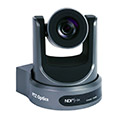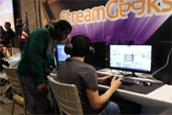PTZOptics Chief Streaming Officer, Paul Richards, has recently published a new book called “Esports in Education.” Richards has agreed to give the book away for free at the link below, but it is also available on Amazon and other platforms. The book takes a deep look into the way Esports is becoming an important part of the education system. From esports clubs to varsity level esports teams at the college and high school levels, this book is ideal for students, educators and parents to read. Richards’s book which is reviewed below by Keith Lutz, shows just how important it is for parents and educators to find common ground through competitive video gaming and esports. Unlike cultural trends of the past, esports is an actual sport that can be encouraged in health and educationally productive ways. Pick up a free copy at the link below and read some of the in-depth reviews on this book below to learn more.
Link to Download Ebook for Free: http://143.198.120.149/book
Link to Buy Book on Amazon: https://www.amazon.com/Esports-Education-Educational-Tournaments-Productions/dp/1673224431/
Link to Enroll in Udemy Course: https://www.udemy.com/course/how-to-start-esports-club/
What are others saying about Esports in Education?

Read this review from Keith Lutz
One of the fastest-growing fields of entertainment this generation, the esports phenomenon is making competitors and investors rich while leaving the rest of us scratching our heads while we try to understand this dynamic new field of sports. Indeed, forming such an understanding is often difficult when you are at the beginning of an industry and esports is very much in its nascent stages. But the one thing that it has proven to fans and naysayers alike is that it is, in every way, a sport. As such, it is situated within a unique and particular cultural history in the West – particularly when it comes to schools. After all, tomorrow’s star football and baseball players often come out of the public school system. This is due to the often impressive programs that some schools field.
We’re talking everything from a culture of sport to a budget to back up the development and nurturing of that spirit. How will esports factor into this cultural understanding in the future? A new ebook offers us a nuanced and timely perspective on how esports and schools fit together both now and into the future. In what can only be called a forward-looking, somewhat visionary work, Paul William Richards explains in “Esports and Education,” that he hopes to “…uncover the need for a strong educational system that can help support student interest in esports” and that he writes it for educators attempting to help students excel in a field of sport in which they have a passion. He identifies this infrastructure as not only crucial for the student’s success but also as a necessity for the thriving entertainment niche itself. He does all of this, “By reviewing the history of video games in our culture and comparing academic papers on relevant subjects” to help situate his recommendations and observations within a historical and cultural context. Essential reading for educators and esports athletes alike, Paul William Richards’ offers a plan for taking esports to the next stage using the foundational platform of the school and educational system to do that.

The central connection that Richards makes between the school community and growing esports niche ties in directly with the school-to-pros pipeline found in other school sports. But it goes so much further than that. Richards makes a point to emphasize that culture and mentoring areas critical to a student athlete’s success as a healthy budget and community support are. Indeed, this direct linkage between the school community itself and esports’ future as an entertainment medium is drawn even further into relief when you consider the concept of esports clubs are a conduit for student-athletes to become professional gamers. See, here the idea of culture and community is challenged by the innovations and revolutions that esports brings with it. Local sports is often regionally confined and then, even at the highest levels, rarely an international competition. By its very accessible nature, esports means borders disappear and regionalism is less important. How do schools grapple with that when regional rivalries and local economies are somewhat reliant upon the rhythm of a local sports’ season? The answer Richards’ offers is part of community involvement and part embracing of a new concept and catapulting it to centrality and primacy.
Again, there is something of a democratic implication to what Richards advocates. Knowing that only the most talented athletes are able to take to the field to represent their school, esports is perhaps a more approachable road to stardom for “everybody else.” The ultimate goal of this approach is not to preference one over the other but to raise them both to equivalency in order to enable maximum participation on the part of students. Engaging students in a meaningful way and harnessing their passion towards future career paths is the goal of Richards’ beliefs and it is a vision that educators and esports aficionados need to notice. Or, as he so eloquently puts it, “All of the traditional values that represent the hard work and patience required to excel in professional sports apply to those who seek excellence in esports. From a perspective of acceptance and encouragement, parents and educators have the chance to find common ground that can help students excel in esports.” Immediately, Richards tackles the idea of esports being something out of the norm or “counterculture.” There is some truth to this notion, but, when situated within broader cultural trends, esports is just one of many cultural evolutions that have broadened the horizons of audiences while creating new industries at the same time.
But esports is also distinctly different from some of the previous trends he identifies such as “grunge” and “punk.” Richards delineates that esports has more immediate community and relevancy to students because of the ease of access to both events and competition itself. When educators and parents alike bemoan the lack of student engagement in schools, Richards rightly highlights this voluntary engagement – and its robust success – as a model for inclusion and community building within schools. The critical nature of sports and community to the development of young minds is underscored when Richards notes that, “Sports are in many ways responsible for helping generations of young people shape their identity. Societies from all around the world inherently understand the value of competitive sports.” In his examination of the history of the medium upon which esports is premised, Richards explains that video games themselves emerged from a kind of “counterculture” and became mainstream only within the most recent past decades.

What this means is that the platform is inherently prone to attracting people who like new and novel experiences as well as those that like to color outside of the lines. Not only are video games a major technological achievement for entertainment, but they are increasingly important in terms of cultural understanding and connection with the broader world. Richards draws this kind of growth and relevance in broad relief while using the details of economic science to underpin his arguments. He writes: “The video gaming industry has surpassed both the movie and music industry’s in total value. In 2019, the movie industry’s estimated value was $136 billion, and the music industry was almost $20 billion. The video game industry is now about to pass $140 billion dollars, a total which has almost doubled over the past ten years. Some reports expect growth from cloud-based and mobile gaming to double the industry once again by 2025 to reach an astonishing $300 billion (Lanier, 2019).” As he outlines the contours of his proposals, Richards makes it very clear that esports isn’t all fun and games. It has real benefits from both a scholastic perspective and in the development of positive life skills. He divides these two positives into two broad categories: Social and cognitive. For starters, those institutions that are pursuing the integration of esports into the curriculum are also backing it up with classes in STEM-related activities.
Richards shows how the act of playing a video gaming and competing in a video game also leads to a passion for creating video games in what can only be termed a virtuous circle of inspiration. Harnessing this cycle for the benefit of the student and the broader community is part of the appeal of esports in school. As he notes, “The North American Scholastic Esports Federation, or NASEF, now offers high school level STEM curriculums that integrate esports into English classes. The curriculum seeks out, ‘explicit connections with esports’ and builds them into an English curriculum.” Moreover, as part of his theme in distinguishing this trend from those of the past, Richards describes the reasons why esports is likely to persist as a force in the entertainment and athletics world. This mainly has to do with the enthusiastic support of the companies that make the games and consoles as well as the sheer size of the audience and community. Because of its borderless nature, esports is, by default, a global sport and competitors from around the world are eligible to watch or play – in theory. This is a fundamentally different perspective than that of say professional football or baseball where the bar to entry is prohibitively high and the qualifications thereof very well known.
Esports remains an unknown quantity, a force for change, sure, but one that many schools and organizations don’t yet understand. In the pursuit of transformative policies with regard to student engagement and performance, systems have to consider the potent impact of things like esports to help motivate students towards one of many potential life paths. Richards has introduced us to the brave new world of esports and all of its promises, but he also implores school systems and communities to exhibit equal courage when it comes to building out the infrastructure and support systems necessary to help its competitors thrive. Whether or not we are up to the challenge is a question that only time can answer.
5 Reasons To Read eSports EDU

When you think of sports, your mind likely goes to a sport with ball throwing, catching, or hitting. This association with competitive sports will most definitely start to change as esports continues to grow with a competitive gameplay type that you can do from the comfort of a chair. Video games have come a long way since its inception over 80 years ago. Now the video game industry has trumped both the music and movie industry in terms of the total value, so it’s no surprise that video games have evolved from casual gameplay on the couch to gamers traveling the world to compete in organized gameplay. The fast-pace the video game industry is moving at an unprecedented rate… But where would you even go to learn how to get started in esports in education? Is there something you can reference to get the insights into esports or how to even set up an event? Fortunately for you, “Esports EDU” covers everything from the history of esports to hosting your own esports tournament. Let’s take a look at 5 reasons to read esports EDU.
5. You, Will, Learn About The Different Types of Esports
Not only will you learn about the different types of esports, but you will learn about the different tournaments that are held around the world. The book goes into the details and examples of Player Vs. Player (PVP), First-Person Shooter (FPS), Real-Time Strategy (RTS), Multiplayer Online Battle Arena Games (MOBA), and Sports Simulation Games. Each genre of the competitive game comes with its own list of games such as popular titles like Fortnite, Mortal Kombat, and League of Legends. After taking a quick overview of the different types of esports you will take a look at an outline worldwide, regional, and educational esports leagues.
4. You, Will, Learn About Different Careers In eSports
Being an esports athlete or coach is nice, but what if you just want to be involved without being the one sitting at the monitor? Who do you think keeps things running? Someone has to organize and set things up, right? How are people even discovered? The industry now has many career paths for students to look forward to including scouts who watch games and find those who have the potential to become athletes for professional franchises. With how quickly esports is growing, it’s an industry that will have many positions opening up for work behind-the-scenes if you’re not an athlete. In fact, it’s a rapidly growing job market with plenty of revenue to cover all the promising opportunities it is opening up.
3. You’ll Read An Insider View Into esports
What better way to learn about the insights of eSports than with an insider interview with some eSports professionals? You will learn their opinions about mental agility as you age, what makes the biggest impact on eSports, and what drives the industry. There’s no better way to learn than from the professionals in the industry themselves.
2. You Will Learn How To Start An esports Club At School
Students involved with an esports club at their school have the opportunity to develop social skills, get people to participate in activities, work on your mental agility, and most importantly, build confidence. This book will cover the ups and downs of starting a school-sponsored club. You may even use the tips you’ll learn here to convince your school to start a varsity level eSports program. You will learn how to get the word out about your ambitions with the club. You might find that it’s a great stress reliever for many students who might not have the best school and life balance. You’ll learn basic organizational skills, team building, branding and marketing, setting up equipment, and everything else you’ll need to know about starting an eSports club at your school.
1. You, Will, Learn About Hosting An eSports Tournament
There’s nothing better than getting students more involved in the community than making them feel like they’re a part of something bigger. Getting students involved in helping set up an eSports tournament will help those who don’t feel very accepted in other aspects of life feel a sense of camaraderie with others who want to work towards the same goal. This is especially important in an age where social anxiety is prevalent because of social media, but it will help teach students important social skills that will help them later in life. Social development is definitely important in a society where “Synthetic Autism” is on the rise. What is “Synthetic Autism?” That is something you will learn if you pick up this book.
This book is an important addition to your repertoire of learning materials if you’re looking to get into eSports and utilizing this growing industry to develop educational skills. This book should also help educate parents on the importance of balancing video games into their child’s life. There seems to be a negative stigma attached to video games as if it were a time waster, but as long as it’s properly balanced with the rest of a child’s responsibilities, then it’s a welcome tool in their toolbox of development. This is definitely a book to read if you want to take a deeper look into the industry.


















